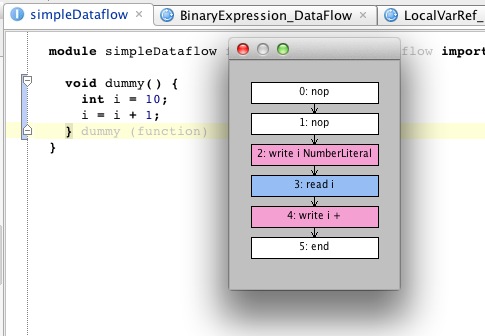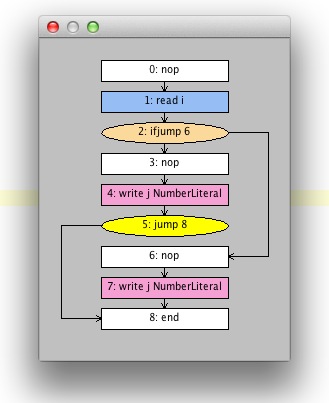HowTo -- Integration with the Data Flow Engine
Dataflow
Data flow analysis supports detecting errors that cannot be found easily by
"looking at the model" with static constraints or type checks. Examples include
dead code detection, missing returns in some branches of a method's body or
statically finding null values and preventing null pointer exceptions.
The foundation for data flow analysis is the so-called data flow graph. This is
a data structure that describes the flow of data through a program's code. For
example, in int i = 42; j = i + 1; the 42 is "flowing" from the init
expression in the local variable declaration into the variable i and then,
after adding 1, into j. Data flow analysis consists of two tasks: building a
data flow graph for a program, and then performing analysis on this data flow
graph to detect problems in the program.
MPS comes with predefined data structures for data flow graphs, a DSL for
defining how the graph can be derived from language concepts (and hence,
programs), a framework for defining your own analyses on the graph as well as a
set of default analyses that can be integrated into your language. We will look
at all these ingredients in this section.
To play with the data flow graph, you can select a method in a Java program and
then use the context menu on the method; select {{Language Debug -> Show Data
Flow Graph}}. This will render the data flow graph graphically and constitutes a
good debugging tool when building your own data flow graphs and analyses.
Building a Data Flow Graph
Simple, Linear Dataflow
In this section we look at the code that
has to be written to create a data flow graph for a language similar to C and
Java (in fact, it is for the mbeddr.com C base language).
Data flow is specified in the Dataflow aspect of language definitions.
Inside that aspect, you can add data flow builders (DFBs) for your language
concepts. These are programs that build the data flow graph for instances of
those concepts in programs. To get started, here is the DFB for
LocalVariableDeclaration.
Let's inspect this in detail. The framework passes in the node variable as
a way of referring to the current instance of the concept for which this DFB is
defined (LocalVariableDecaration here). If the
LocalVariableDecaration has an init expression (it is optional!), then the
DFB for the init expression has to be executed. The code for statement
does this: it "calls" the DFB for the node that is passed as its argument. Then
we perform an actual data flow definition: the write node = node.init
specifies that write access is performed on the current node (there is also a
read statement; this support detection of read-before-write errors). The
statement also expresses that whatever value was in the init expression is now
in the node itself.
If there is no init expression, we still want to mark the
LocalVariableDeclaration node as visited — the program flow has come
across this node. A subsequent analysis reports all program nodes that have
not been visited by a DFB as dead code. So even if a node has no further
effect on a program's data flow, it has to be marked as visited using nop.
To illustrate a read statement, one can take a look at the
LocalVariableRef expression which read-accesses the variable it
references. Its data flow is defined as read node.var}, where {{var} is
the name of the reference that points to the referenced variable. Here is the
code:
For an AssignmentStatement, the data flow is as follows:
Note how we first execute the DFB for the rvalue and then "flow" the
rvalue into the lvalue — the purpose of an assignment.
For a StatementList, we simply mark the list as visited and then execute
the DFBs for each statement:
Finally, for a C function, at least for now, ignoring arguments, the DFB simply
calls the DFB for the body, a StatementList.
We are now ready to inspect the data flow graph for a simple function.
Below is the graph for the function.

Data flow analysis is typically limited to one function, method or similar
concept. To signal the end of a one of those, we should use the ret
statement. To illustrate this, here is the DFB for the ReturnStatement:
Branching
Linear dataflow, as described above, is relatively
straight forward (no pun intended ). However, most interesting data flow
analysis has to do with loops and branching. So specifying the correct DFBs for
things like if, switch and for is important. It is also not as
simple\ldots
Let us take a step-by-step look at the DFB for the IfStatement. We start
with the obligatory nop to make the node as visited. Then we run the DFB
for the condition, because that is evaluated in any case. Then it becomes
interesting: depending on whether the condition is true or false, we either run
the thenPart} or we jump to where the {{else if parts begin. Here is
the code so far:
The ifjump statement means that we may jump to the specified label (i.e.
we then execute the {{else if}}s). If not (we just "run over" the
ifjmp}), then we execute the {{thenPart. If we execute the
thenPart}, we are finished with the whole {{IfStatement — no
else if}s or {{else parts are relevant, so we jump after the current
node (the IfStatement) and we're done. However, there is an additional
catch: in the thenPart}, there may be a {{return statement. So we may
never actually arrive at the jump after node statement. This is why it is
enclosed in curly braces: this says that the code in the braces is optional. If
the data flow does not visit it, that's fine (typically because we return from
the method before we get a chance to execute this code).
Let's continue with the else if}s. We arrive at the {{elseIfBlock label
if the condition was false, i.e. the above ifjump actually happened. We
then iterate over the {{elseIf}}s and execute their DFB. After that, we run
the code for the elsePart, if there is one. The following code can only be
understood if we know that, if we execute one of the {{else if}}s, then we
jump after the whole IfStatement. This is specified in the DFB for
the ElseIfPart, which we'll illustrate below. Here is the rest of the code
for the IfStatement's DFB:
We can now inspect the DFB for the ElseIfPart. We first run the DFB for
the condition. Then we may jump to after that else if, because the
condition may be false and we want to try the next else if, if there is
one. Alternatively, if the condition is true, we then run the DFB for the body
of the ElseIfPart. Then two things can happen: either we jump to after
thoe whole IfStatement} (after all, we have found an {{else if that is
true), or we don't do anything at all anymore because the current else if
contains a return statement. So we have to use the curly braces again for the
jump to after the whole if. Here is the code:
The resulting data flow graph is shown below.

Loops
To wrap up data flow graph construction, we can take a
look at the for loop. This is related to branching again, because after
all, a loop can be refactored to branching and jumps. Here is the DFB for the
for loop:
We first execute the DFB for the iterator (which is a kind of
LocalVariableDeclaration, so the DFB for it above works). Then we define a
label start so we can jump to this place from further down. We then
execute the condition}. Then we have an {{ifjmp to after the whole loop
(which covers the case where the condition is false and the loop ends). In the
ohter case (the condition is still true) we execute the code for the body
and the incr} part of the {{for loop We then jump to after the
start label we defined above.
Integrating Data Flow Checks into your Language
Data flow checks are triggered from NonTypesystemRules. There is a bit of
procedural code that needs to be written, so we create a class
DataflowUtil in the typesystem aspect model.
The class constructs a {{Program} object in the constructor. {{Program}}s
are wrappers around the data flow graph and provide access to the graph, as well
as to a set of predefined analyses on the graph. We will make use of one of them
here in the checkForUnreachableNodes method. This method extracts all
unreachable nodes from the graph (see comments in the code above) and reports
errors for them. To be able to use the error statement, we have to
annotate the method with the @CheckingMethod annotation.
To actually run the check, we call this method from a NonTypesystemRule
for C functions:
Inspecting the Program class, you can see the set of existing other data
flow analyses: uninitialized reads (read before write), unreachable instructions
(dead code) and unused assignments. We'll look at what to do if those aren't
enough in the next section.
Building your own Analyzers
Data flow analysis is a non trivial topic. To build meaningful analyses you will
probably need a background in this topic, or read up on the respective
literature.
For the actual integration of custom data flow analyses, we will provide an
additional article later.